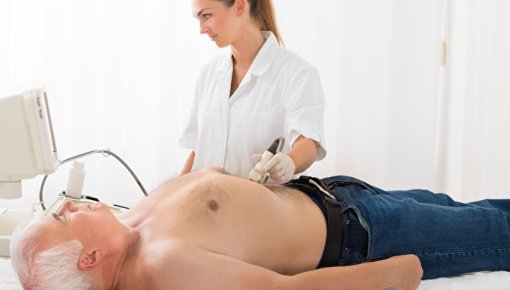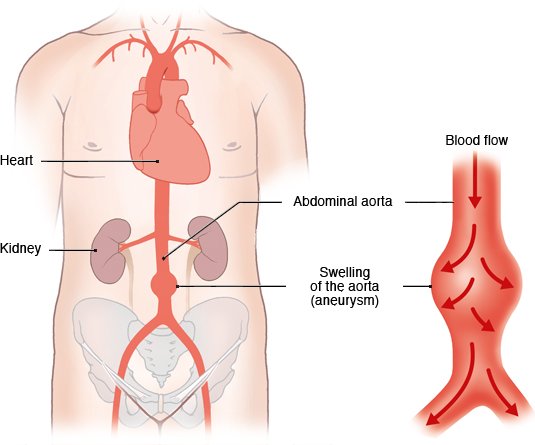Ali MU, Fitzpatrick-Lewis D, Kenny M et al. A systematic review of short-term vs long-term effectiveness of one-time abdominal aortic aneurysm screening in men with ultrasound. J Vasc Surg 2018; 68(2): 612-623.
Antoniou GA, Antoniou SA, Torella F. Editor's Choice - Endovascular vs. Open Repair for Abdominal Aortic Aneurysm: Systematic Review and Meta-analysis of Updated Peri-operative and Long Term Data of Randomised Controlled Trials. Eur J Vasc Endovasc Surg 2020; 59(3): 385-397.
Deutsche Gesellschaft für Gefäßchirurgie und Gefäßmedizin - Gesellschaft für operative, endovaskuläre und präventive Gefäßmedizin (DGG). S3-Leitlinie zu Screening, Diagnostik, Therapie und Nachsorge des Bauchaortenaneurysmas. AWMF-Registernr.: 004-014l (in Überarbeitung). 2023.
Golledge J, Singh TP. Effect of blood pressure lowering drugs and antibiotics on abdominal aortic aneurysm growth: a systematic review and meta-analysis. Heart 2021; 107(18): 1465-1471.
Guirguis-Blake JM, Beil TL, Senger CA, Coppola EL. Primary Care Screening for Abdominal Aortic Aneurysm: A Systematic Evidence Review for the U.S. Preventive Services Task Force. (AHRQ Evidence Syntheses; No. 184). 2019.
Guirguis-Blake JM, Beil TL, Senger CA, Coppola EL. Primary Care Screening for Abdominal Aortic Aneurysm: Updated Evidence Report and Systematic Review for the US Preventive Services Task Force. JAMA 2019; 322(22): 2219-2238.
Institute for Quality and Efficiency in Health Care (IQWiG, Germany). Ultrasound screening for abdominal aortic aneurysms: Final report; Commission S13-04. 2015.
Institute for Quality and Efficiency in Health Care (IQWiG, Germany). Information for health insurance fund members on ultrasound screening for abdominal aortic aneurysms – addendum to commission S13-04; Commission P16-01. 2016.
Isselbacher EM, Preventza O, Hamilton Black J et al. 2022 ACC/AHA Guideline for the Diagnosis and Management of Aortic Disease: A Report of the American Heart Association/American College of Cardiology Joint Committee on Clinical Practice Guidelines. Circulation 2022; 146(24): e334-e482.
Lancaster EM, Gologorsky R, Hull MM et al. The natural history of large abdominal aortic aneurysms in patients without timely repair. J Vasc Surg 2022; 75(1): 109-117.
Mazzolai L, Teixido-Tura G, Lanzi S et al. 2024 ESC Guidelines for the management of peripheral arterial and aortic diseases: Developed by the task force on the management of peripheral arterial and aortic diseases of the European Society of Cardiology (ESC) Endorsed by the European Association for Cardio-Thoracic Surgery (EACTS), the European Reference Network on Rare Multisystemic Vascular Diseases (VASCERN), and the European Society of Vascular Medicine (ESVM). Eur Heart J 2024; 45(36): 3538-3700.
National Institute for Health and Care Excellence (NICE). Abdominal aortic aneurysm: diagnosis and management (NICE Guidelines; No. NG156). 2020.
Paravastu SC, Jayarajasingam R, Cottam R et al. Endovascular repair of abdominal aortic aneurysm. Cochrane Database Syst Rev 2014; (1): CD004178.
Parkinson F, Ferguson S, Lewis P et al. Rupture rates of untreated large abdominal aortic aneurysms in patients unfit for elective repair. J Vasc Surg 2015; 61(6): 1606-1612.
Wanhainen A, Van Herzeele I, Bastos Goncalves F et al. Editor's Choice - European Society for Vascular Surgery (ESVS) 2024 Clinical Practice Guidelines on the Management of Abdominal Aorto-Iliac Artery Aneurysms. Eur J Vasc Endovasc Surg 2024; 67(2): 192-331.
IQWiG health information is written with the aim of helping people understand the advantages and disadvantages of the main treatment options and health care services.
Because IQWiG is a German institute, some of the information provided here is specific to the German health care system. The suitability of any of the described options in an individual case can be determined by talking to a doctor. informedhealth.org can provide support for talks with doctors and other medical professionals, but cannot replace them. We do not offer individual consultations.
Our information is based on the results of good-quality studies. It is written by a team of health care professionals, scientists and editors, and reviewed by external experts. You can find a detailed description of how our health information is produced and updated in our methods.


